I was 18 when my bowel troubles began. At the time, I was playing a lot of football and just starting to go out and party with friends. After some nasty symptoms, I went to the doctor, where I was diagnosed with ulcerative colitis (UC), a kind of inflammatory bowel disease (IBD) that just affects the large bowel, the colon. It was a real blow, as everything was put on hold. My footballing stopped totally, as I began to sink into embarrassment and depression over having to constantly rush to the toilet.
Last resort
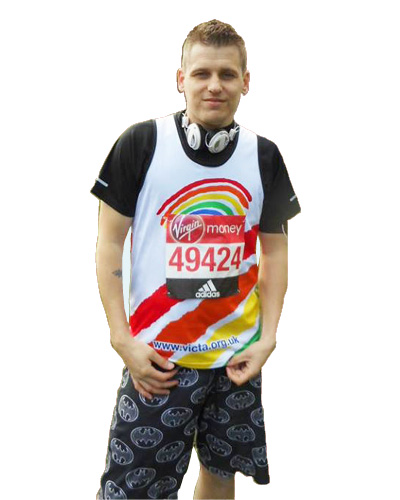 I put up with my inflamed colon as best as I could, but eventually, after 4 long years, I agreed with my IBD team that it was just too much to handle, and I would be better off without it! I was so ill, and so desperate to feel better, that it was time for the last resort. The team showed me a smart surgical technique, called a J‑pouch, that would allow me to go to the loo more or less as normal. To form a J‑pouch, the colon is removed, and the bottom end of the longer small intestine is turned up in a J shape and refashioned into a pouch. This pouch performs the colon’s job, storing the bowel’s contents between trips to the loo.
I put up with my inflamed colon as best as I could, but eventually, after 4 long years, I agreed with my IBD team that it was just too much to handle, and I would be better off without it! I was so ill, and so desperate to feel better, that it was time for the last resort. The team showed me a smart surgical technique, called a J‑pouch, that would allow me to go to the loo more or less as normal. To form a J‑pouch, the colon is removed, and the bottom end of the longer small intestine is turned up in a J shape and refashioned into a pouch. This pouch performs the colon’s job, storing the bowel’s contents between trips to the loo.
As a new pouch needs some time to heal before it can be used, if I wanted one, I had to agree to have a temporary ileostomy for a few months to divert the flow and let the pouch settle down. I agreed, and the operation went ahead.
‘it was time for the last resort’
Once I’d recovered from the operation, life with a J‑pouch seemed far better than having UC. I felt amazing, and I could finally go socialising with my friends and even play football again, as long as I wore a guard.
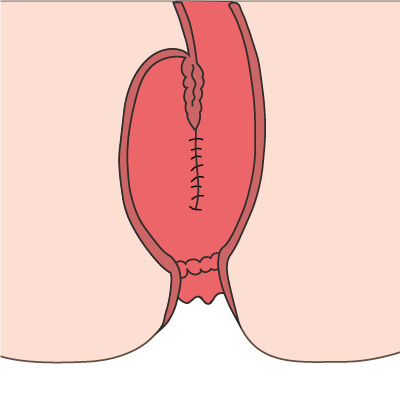
The J‑pouch is an artificial reservoir made from a loop of small intestine
False start
After 6 months, I thought I was saying goodbye to my stoma for good. However, it’s impossible to predict how easily a J‑pouch will settle, and after being reconnected mine did not get off to a great start. It soon became inflamed, a condition imaginatively named pouchitis. ‘Here we go again,’ I thought; as soon as I began to believe it was all better, it all started happening again. Before long, I was back with my ileostomy while it calmed down. Still, I was fairly happy knowing it was only meant to be a temporary solution. For a few months, I was a recluse again, hiding in my house until it all passed.
‘I was having a great time’
Luckily, this time it worked, and my J‑pouch and I had 8 good years together, with only a few flare-ups caused by blockages and my rectum tightening up. For the rest of my twenties, I was having a great time. I was eating what I wanted and going on holidays with the lads. Daily life was back to normal, bar a few extra trips to the toilet—nothing too bad!
Here comes trouble
As I turned 30, I was married to my wife, Sarah, and we were expecting our first child. We’d met as colleagues, working through the same shift, and we were married within 11 months. For most of its life, the pouch was no trouble at all for our relationship.
However, in April 2014, when my wife was half way through her pregnancy, I suddenly began to feel dizzy and tired. I noticed a massive red patch on my bum cheek, which was very sensitive to the touch. A quick online search of the symptoms suggested it might be an abscess. I was rushed to hospital, where I learned that I had sepsis, a rare and very dangerous condition caused by the body’s response to a serious infection. The infection was gathering in internal abscesses, and these were feeding off my J‑pouch via an abnormal passage, called a fistula. The doctors said as it was one of the biggest abscesses they had ever dealt with, and I was lucky to have woken up that night. To save my life, I was put in a medically induced coma.
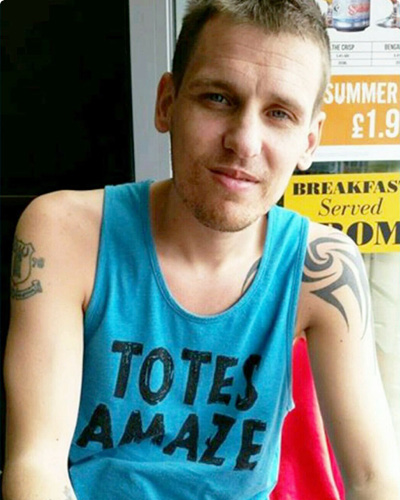
Not feeling so great
Third time unlucky
I woke up in intensive care to find that I had my third temporary ileostomy! Once again, my pouch needed to recover. Not only that, but while recovering I had missed hearing my child’s heartbeat for the first time.
The abscesses proved difficult to control, and I was in and out of hospital for 6 months. A plastic band called a seton was used to keep the passages open while they drained. New abscesses were lanced, and each day the drained ones were packed with absorbent material.
With all this work being done to me, and the constant leaking from my rectum, I was extremely weak. What was more, around this time it was discovered that I actually had Crohn’s disease, the type of IBD that affects the entire gastrointestinal tract, not just the end bit. I was made aware of all the risks. For the first time, my condition began to get between me and Sarah, as I wouldn’t open up to her about the constant leaking, and it made me so embarrassed that I became reluctant to go near her.
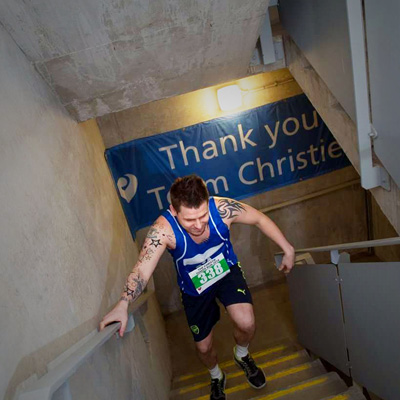
Stair run
Decisions decisions
The day my son Noah was born I was still so sick with worry about developing another abscess that I hardly took in what was happening. We were lucky, as the birth was only 3.5 hours long, so I could sit without worrying too much about a leak. However, I was so weak that I can barely remember a thing from that day.
I spent the first half-year of his life fighting as hard as I could to save my J‑pouch and avoid a permanent ileostomy. I was afraid of having to face other people’s opinions for the rest of my life. I was worried about how friends and family would treat me, and how the general public would react when I took my top off.
I have always been an active person, so being stuck inside with a weakening body was seriously affecting me, emotionally as well as physically. My weight had dropped to 9 stone, and no matter how much I ate, I couldn’t bring it up again. Still, I knew, if I had a permanent stoma, it would be a challenge when it came to physical activity for the rest of my life. I was desperate to get out again, so I had to face the choice of whether it would be better than a problematic J‑pouch.
I also understood that surgery for a permanent stoma carries a risk of impotency. I saw myself as a family man, and the possibility of not being able to have any more children was unthinkable. However, I began to realise that my determination not to have a permanent ileostomy was making me so weak that it prevented me from being able to hold and play with my son, and I wasn’t able to live the family life I had hoped for.
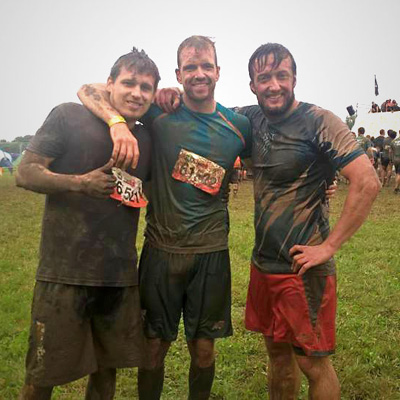
Tough Mudder
Everything out
I told my consultant what I was missing out on, and together we decided to have everything removed and a permanent ileostomy formed. I had heard all about the challenges and potential complications, but was determined to prove my surgeon wrong, especially when it came to exercise
In June 2015, my J‑pouch was removed, and I went permanent, using the same stoma from my third operation. Since then I have never been better!
‘I would do even more!’
The patient support networks for ostomates and IBD, such as Merseyside Crohn’s and Colitis UK and Meet an Ostomate, have been a big help. I wish I had known about them earlier, because I think if I had been in touch with them before my operation, I would have made the decision to go permanent much sooner. I learned not to worry about other people’s reactions. Seeing what other ostomates had gone on to do after their operations was reassuring and inspirational, as it showed that a stoma not define or seriously hinder your life.
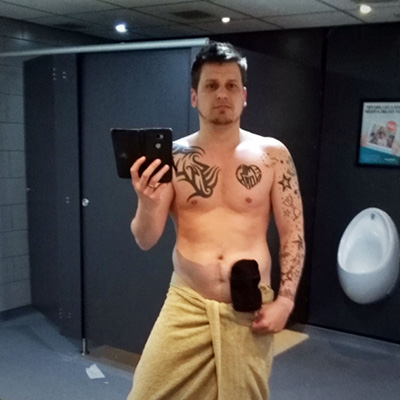
Hitting 83 kg in 2018
Bouncing back
After my operation and speaking to fellow ostomates, I not only felt that I would be able to do everything I had been doing before, but in fact I would do even more!
I went from being scarcely able to move at all to hitting the gym within 3 months. Supported by a stoma belt with a cup protector, and armed with plenty of isotonic drinks and Jelly Babies, I got to work. After 3 solid months of training, I ran the London Marathon within less than a year of my operation. I’d never heard of anyone else with a stoma completing one, so it felt great. I also did a Tough Mudder obstacle course and two stair climbs, where I ran up all 798 steps of the 46 floors of Manchester’s Beetham Tower, all in 9 minutes and 20 seconds. and the London Marathon. It felt amazing just to do normal things again.
Heaving a stoma has meant I haven’t needed to worry much about what I can and can’t eat, which has allowed me to build my strength back up. I now weigh 83 kg, up from 57 kg before the operation, and I feel I am the healthiest I have ever been.
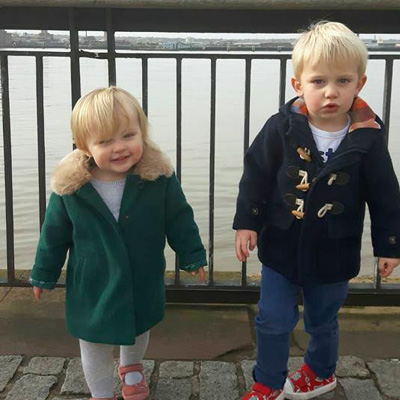
Emily and Noah
New life
I was right that after a permanent ileostomy my life would never be the same again, but not in the way I expected. Having a stoma has meant I can play with my son as he grows up. Best of all, in April 2016, Sarah and I welcomed our little girl, Emily, into the world.
 Alan Northey lives in Liverpool with his wife, Sarah, and their children, Emily and Noah
Alan Northey lives in Liverpool with his wife, Sarah, and their children, Emily and Noah
The contents of this page are property of MA Healthcare and should not be reused without permission

